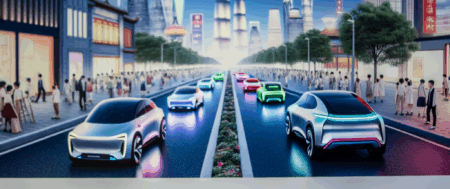China, the world’s largest automotive market, is a top battleground for both foreign automakers and domestic car brands, driven by its growing economy, urbanization, and an expanding middle class’s demand for vehicles, especially Electric Vehicles (EVs) and New Energy Vehicles (NEVs). Success in this competitive market relies on navigating a complex regulatory landscape, adapting to consumer preferences, and leveraging technological advancements. Strategic partnerships, including joint ventures, are crucial for meeting regulatory demands and seizing the vast consumer base. Collaborations with technology firms and suppliers are also vital to stay competitive and align with environmental concerns through government incentives. As China leads in promoting EVs and NEVs, understanding government policies, market competition, and consumer trends is key for any player aiming to thrive.
In the fast-paced lanes of global commerce, the China automotive market stands as a colossus, driving ahead as the world’s largest automotive market. With a blend of top-tier production and sales volumes, this market’s engine is fueled by China’s rapidly growing economy, expanding urbanization, and the rising affluence of its burgeoning middle class. As a pivotal arena for both domestic car brands and foreign automakers, China’s automotive sector is a complex interplay of consumer preferences, strategic partnerships, and a regulatory landscape that requires adept navigation. The shift towards Electric Vehicles (EVs) and New Energy Vehicles (NEVs) is accelerating, powered by government incentives and mounting environmental concerns, positioning China at the forefront of the automotive industry’s sustainable future.
This article delves deep into the intricate gears of the Chinese automotive market, exploring the robust dynamics that make it a highly competitive yet lucrative sector. From “Navigating the Terrain” of regulatory frameworks and strategic alliances to “Revving Up” the market with insights on economic and urban growth fueling automotive demand, we explore every facet that contributes to China’s dominance in the global automotive scene. The surge in EVs and NEVs, driven by “Charging Forward,” highlights China’s commitment to innovation and sustainability, while “Crossing Borders” examines the critical role of joint ventures in bridging the gap between foreign automakers and domestic car brands.
Further, we analyze “Driving Desires” to understand the evolving consumer preferences that dictate market trends, alongside “Green Gears,” where government incentives and environmental concerns steer the market towards a greener horizon. “The Innovation Engine” section sheds light on the technological advancements propelling the industry forward, and finally, “The Competitive Circuit” provides a comprehensive view of the market competition that defines the thriving automotive sector in China.
Understanding the China automotive market is pivotal for industry stakeholders looking to navigate its vast landscape successfully. This article offers a roadmap to mastering the complexities of the world’s largest automotive market, highlighting the strategic partnerships, regulatory insights, and market understanding necessary to accelerate in this dynamic and challenging environment.
1. “Navigating the Terrain: Understanding the Regulatory Landscape and Strategic Partnerships in the World’s Largest Automotive Market”

Navigating the complex and dynamic terrain of the world’s largest automotive market requires a keen understanding of the intricate regulatory landscape and the importance of strategic partnerships. China’s position as the top automotive market is bolstered by its rapidly growing economy, increasing urbanization, and the expanding middle class, all of which fuel a high demand for both domestic car brands and foreign automakers. This demand spans traditional vehicles and is particularly strong for Electric Vehicles (EVs) and New Energy Vehicles (NEVs), driven by environmental concerns and significant government incentives.
The regulatory landscape in China is multifaceted, with policies aimed at promoting the development and adoption of EVs and NEVs to position China as a leader in this emerging market. Foreign automakers looking to tap into this lucrative market face a complex web of regulations and are often required to form joint ventures with local Chinese companies. These joint ventures allow for a sharing of expertise and resources, facilitating navigation through the regulatory environment while accessing the vast consumer base. However, they also necessitate a deep understanding of local consumer preferences, technological advancements, and market competition.
Consumer preferences in China are evolving, with a growing emphasis on technological innovation, sustainability, and brand reputation. This shift is influencing the market competition, pushing companies to innovate and adapt to maintain a competitive edge. Technological advancements, particularly in the realm of EVs and NEVs, are rapidly changing the landscape of the automotive industry, with China at the forefront of these developments.
Strategic partnerships extend beyond joint ventures and include alliances with technology companies, suppliers, and even competitors to leverage collective strengths in technology, manufacturing, and marketing. These collaborations are essential for foreign and domestic car brands alike to succeed in China’s highly competitive automotive market. They enable companies to pool resources, share risks, and capitalize on each other’s strengths to meet the fast-evolving demands of Chinese consumers.
Moreover, government incentives play a pivotal role in shaping the market dynamics, encouraging both manufacturers and consumers to lean towards more environmentally friendly transportation options. These incentives, coupled with stringent environmental regulations, underscore the government’s commitment to reducing pollution and leading the global transition to a greener automotive industry.
In conclusion, understanding the regulatory landscape and the importance of strategic partnerships is crucial for any player in the largest automotive market. Success in China’s automotive sector requires a blend of navigating government policies, aligning with consumer preferences, leveraging technological advancements, and forming strategic partnerships. As the market continues to evolve, companies that can adeptly manage these aspects will be well-positioned to thrive in the competitive landscape of China’s automotive industry.
In conclusion, the China automotive market stands as a beacon of opportunity and challenge within the global automotive industry. Positioned as the largest automotive market, it continues to grow and evolve, driven by a robust economy, rapid urbanization, and an expanding middle class with increasing demands and preferences for mobility solutions. The market’s distinct tilt towards Electric Vehicles (EVs) and New Energy Vehicles (NEVs), fueled by environmental concerns and generous government incentives, has set a unique course for both domestic car brands and foreign automakers.
Navigating this landscape requires a deep understanding of the regulatory environment, which is both a barrier and a gateway for companies aiming to penetrate this lucrative market. Joint ventures have emerged as a strategic pathway, enabling international brands to tap into the vast consumer base while adhering to local guidelines. This symbiotic relationship between foreign automakers and Chinese companies underscores the importance of strategic partnerships in overcoming the complexities of the regulatory landscape.
Moreover, the market’s dynamism is shaped by consumer preferences, technological advancements, and the overarching influence of government policies. The competitive arena is not just about offering innovative products but also about adapting to the rapidly changing market conditions, influenced by global economic trends and local environmental policies.
Understanding the China automotive market requires a multifaceted approach, considering all the elements from market competition to strategic partnerships, and from the regulatory landscape to consumer behaviors. For companies willing to navigate these waters, the rewards can be substantial, but success hinges on their ability to adapt, innovate, and forge meaningful collaborations. As we look to the future, the China automotive market remains a critical piece of the global automotive puzzle, reflecting broader trends in urbanization, environmental responsibility, and the shifting sands of consumer demand.






